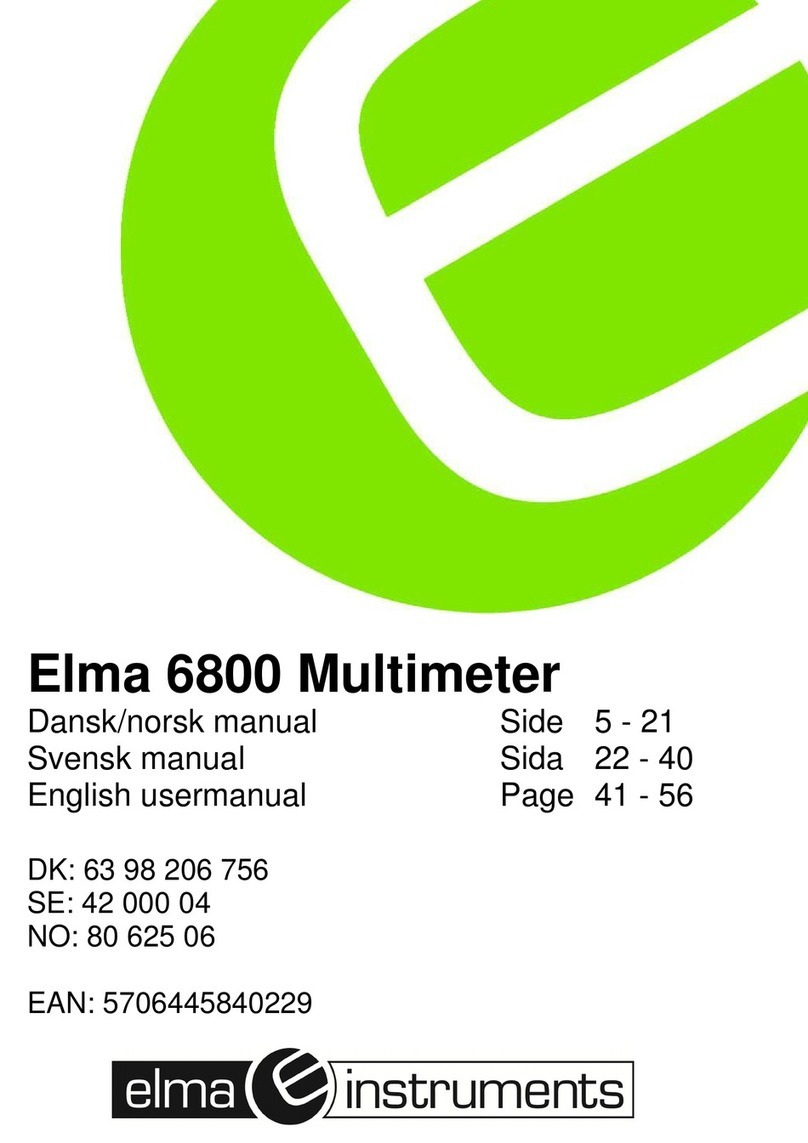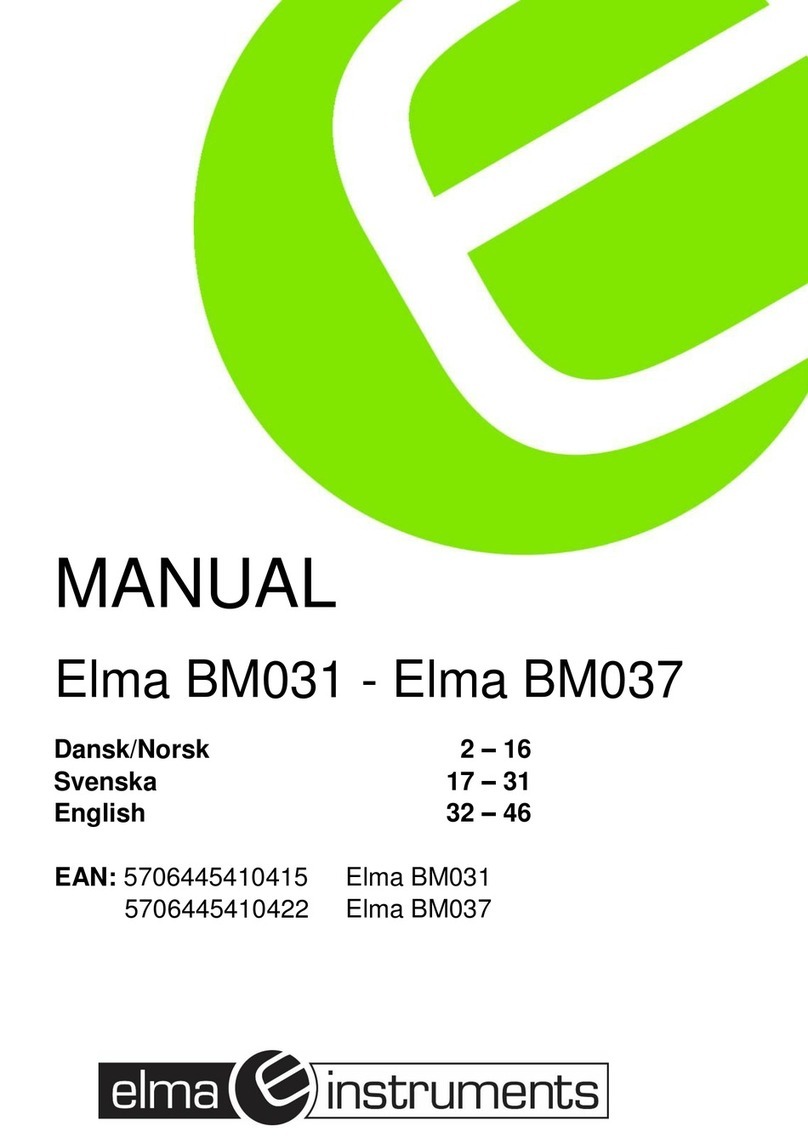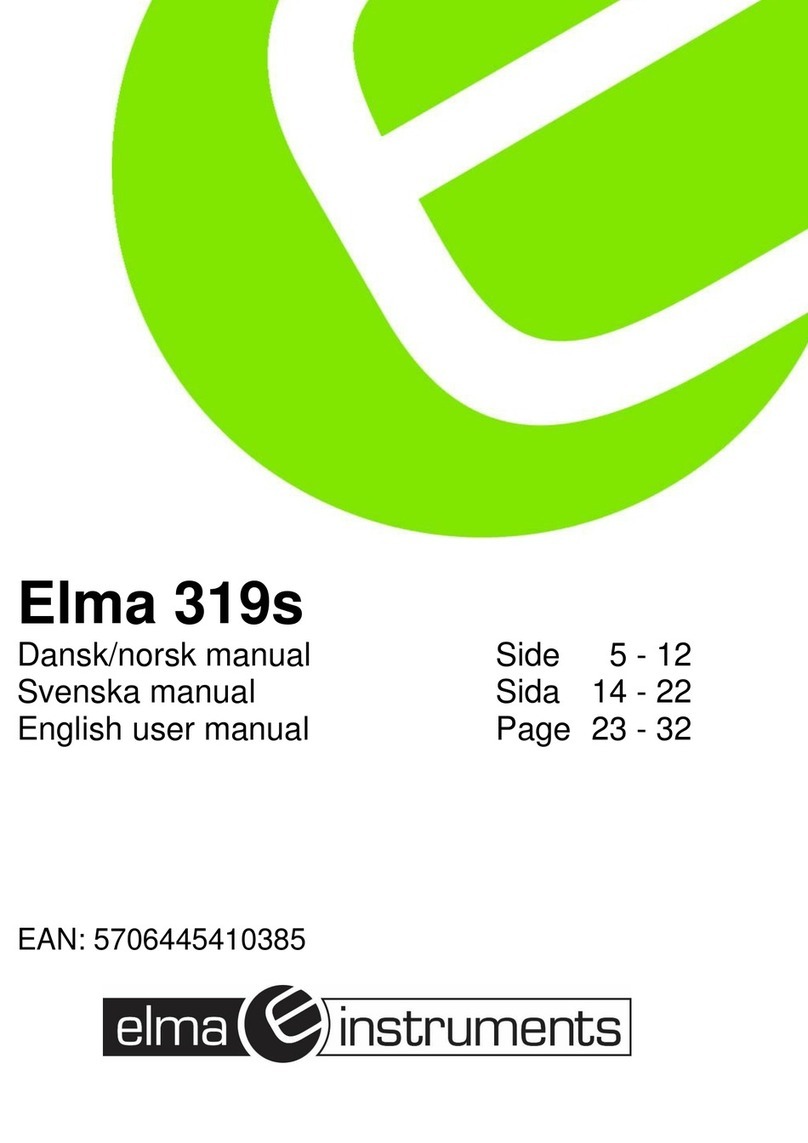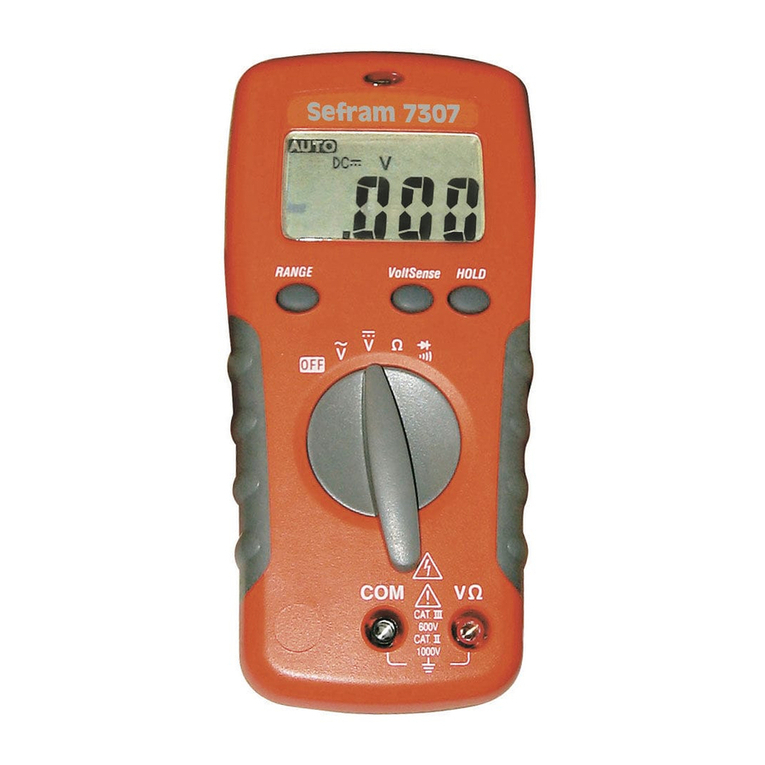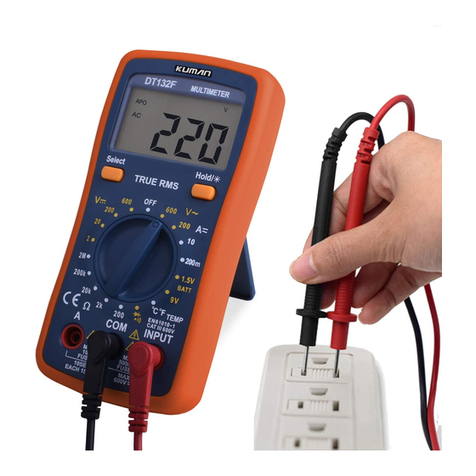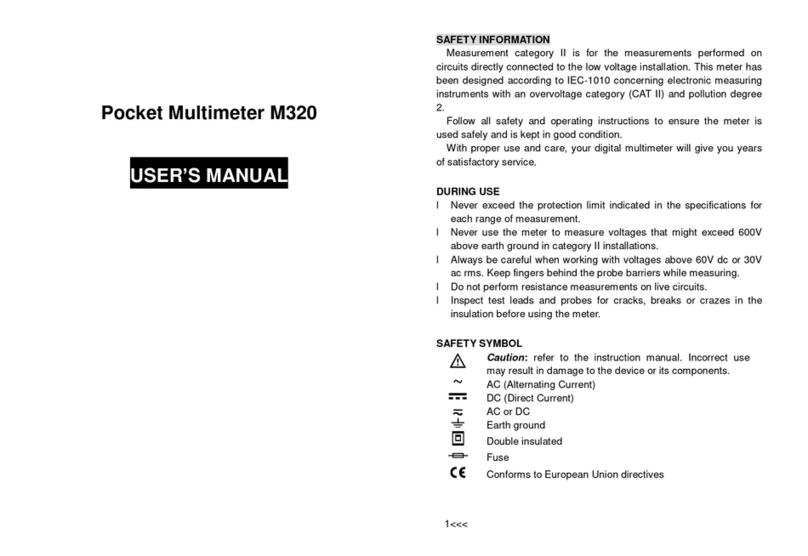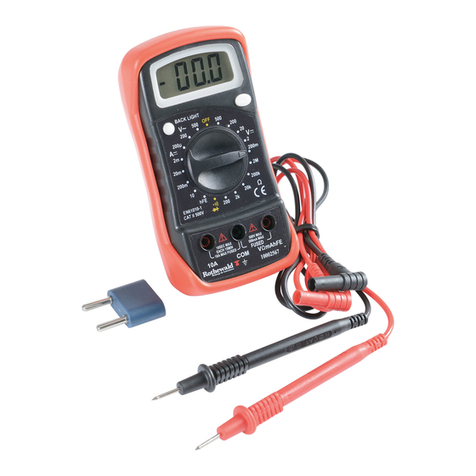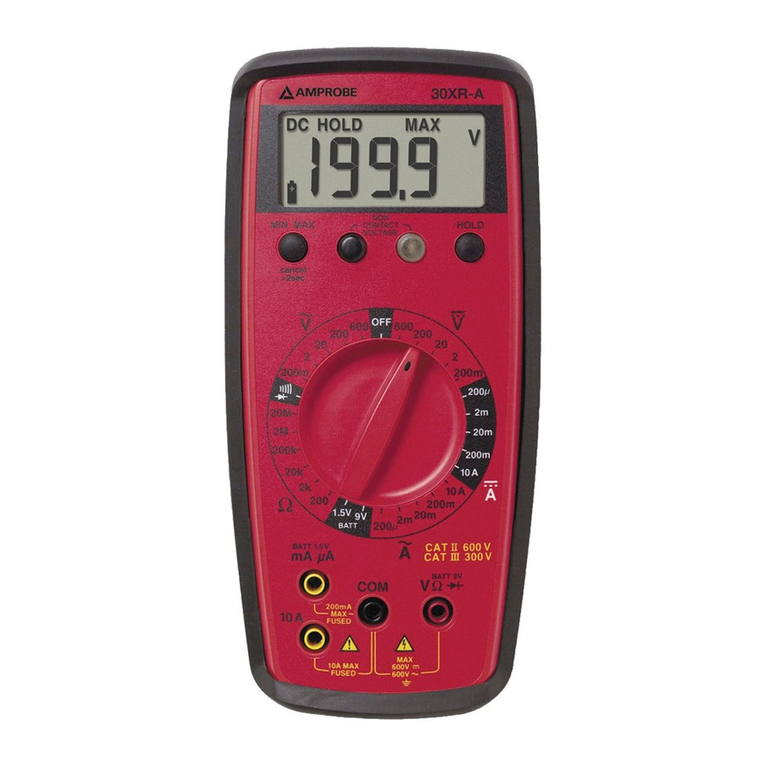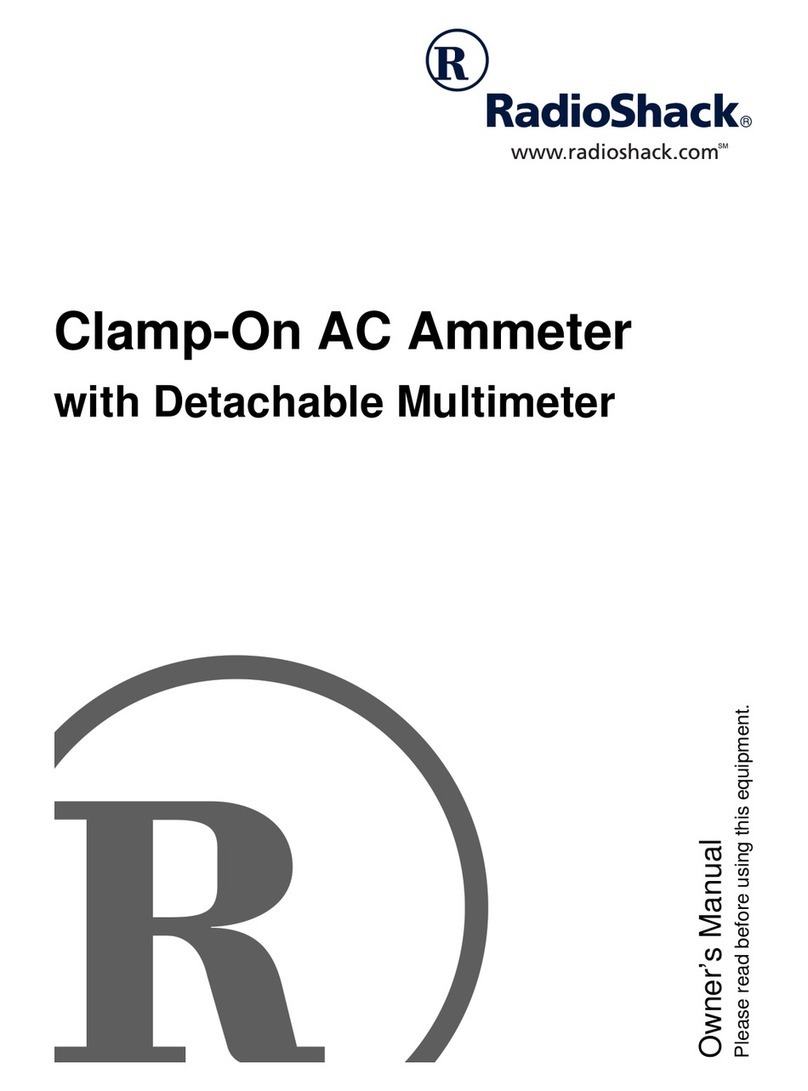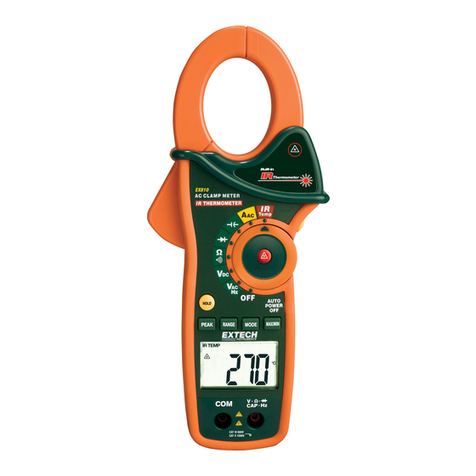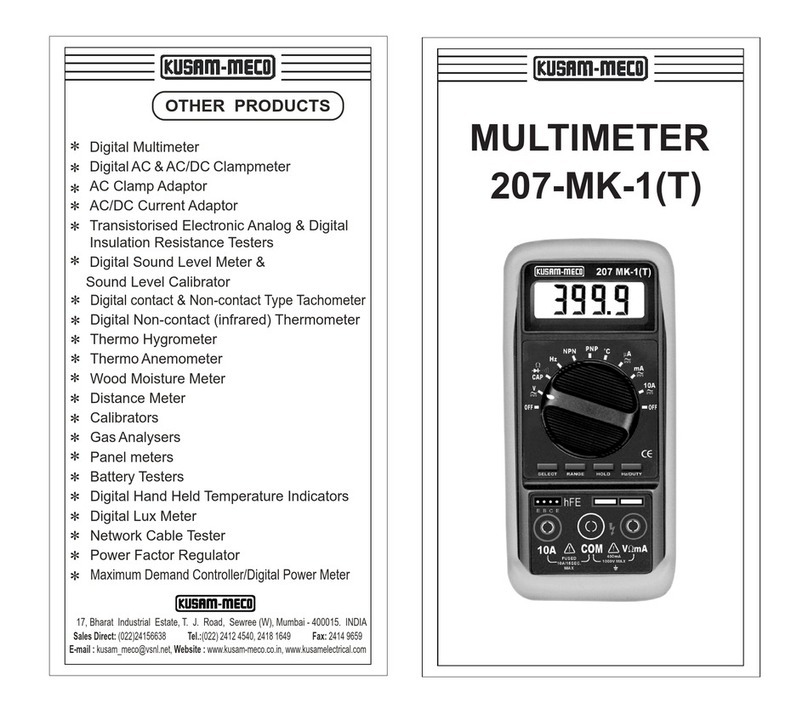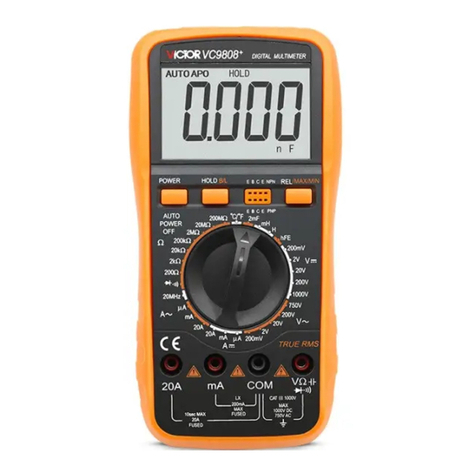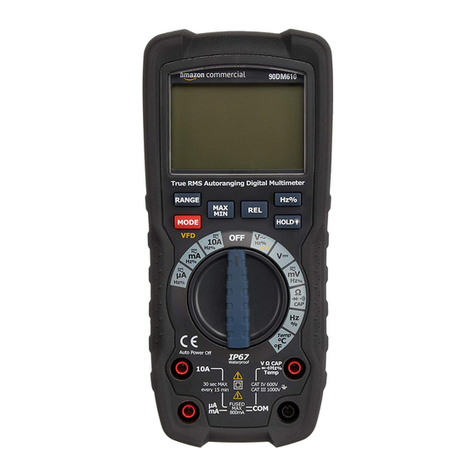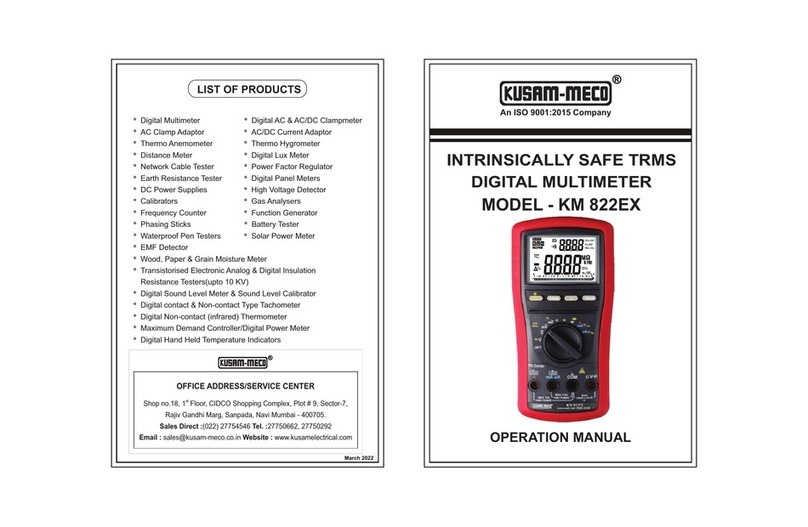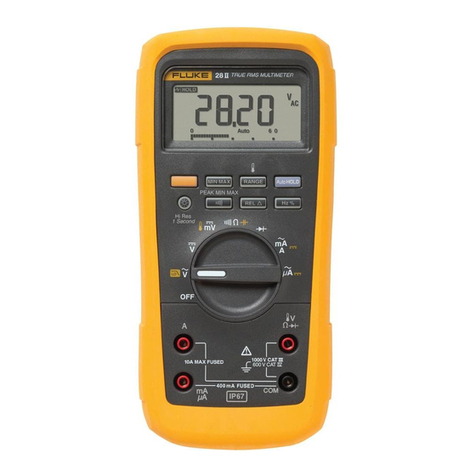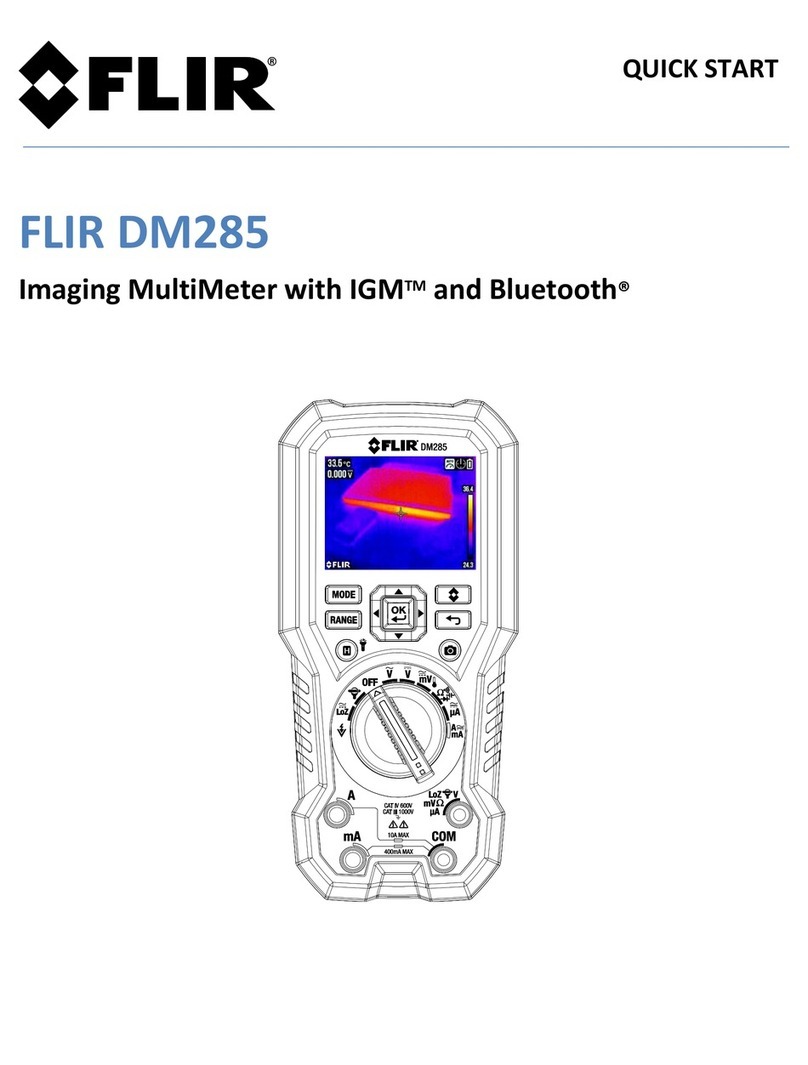Elma Instruments 25 User manual

Elma 257s
Elma 25x
User manualhttps://www.elso.sk/product.php?id_product=3221

Elma BM 251-252-255-257
side 34
English usermanual
Elma 251-252-255-257
Safety
Terms in this manual
WARNING identifies conditions and actions that could result in serious injury
or even death to the user.
CAUTIONidentifies conditions and actions that could cause damage or malfunction in
the instrument.
This manual contains information and warnings that must be followed for operating the
instrument safely and maintaining the instrument in a safe operating condition. If the
instrument is used in a manner not specified by the manufacturer, the protection provided
by the instrument may be impaired. The meter is intended only for indoor use.
The meter protection rating, against the users, is double insulation per IEC61010-1 2nd
Ed., EN61010-1 2nd Ed., UL61010-1 2nd Ed. and CAN/CSA C22.2 No. 61010.1-0.92 to
Category II 1000V, CAT III 600V and CAT IV 300V AC & DC.
Terminals (to COM) measurement category:
V : Category II 1000V, CAT III 600V and CAT IV 300V AC & DC.
mAµA : Category III 500Vac and 300Vdc.
A : Category III 600Vac and 300Vdc.
Per IEC61010-1 2nd Ed. (2001) Measurement Category
Measurement Category IV (CAT IV) is for measurements performed at the source
of the low-voltage installation. Examples are electricity meters and measurements on
primary overcurrent protection devices and ripple control units.
Measurement Category III (CAT III) is for measurements performed in the building
installation. Examples are measurements on distribution boards, circuit- breakers, wiring,
including cables, bus-bars, junction boxes, switches, socket-outlets in the fixed installation,
and equipment for industrial use and some other equipment, for example, stationary
motors with permanent connection to the fixed installation.
Measurement Category II (CAT II) is for measurements performed on circuits
directly connected to the low voltage installation. Examples are measurements on
household appliances, portable tools and similar equipment.

Elma BM 251-252-255-257
side 35
WARNING
To reduce the risk of fire or electric shock, do not expose this product to rain or moisture.
To avoid electrical shock hazard, observe the proper safety precautions when working with
voltages above 60 VDC or 30 VAC rms. These voltage levels pose a potential shock
hazard to the user. Do not touch test lead tips or the circuit being tested while power is
applied to the circuit being measured. Keep your fingers behind the finger guards of the
test leads during measurement. Inspect test leads, connectors, and probes for damaged
insulation or exposed metal before using the instrument. If any defects are found, replace
them immediately. Do not measure any current that exceeds the current rating of the
protection fuse. Do not attempt a current measurement to any circuit where the open
circuit voltage is above the protection fuse voltage rating. Suspected open circuit voltage
should be checked with voltage functions. Never attempt a voltage measurement with the
test lead inserted into the µA/mA or A input jack. Only replace the blown fuse with the
proper rating as specified in this manual.
CAUTION
Disconnect the test leads from the test points before changing functions. Always set the
instrument to the highest range and work downward for an unknown value when using
manual ranging mode.
International elctrical symbols
!
!!
!Caution ! Refer to the explanation in this Manual
Caution ! Risk of electric shock
Earth (Ground)
Double Insulation or Reinforced insulation
Fuse
AC--Alternating Current
DC--Direct Current
Cenelec directives
The instruments conform to CENELEC Low-voltage directive 2006/95/EC and
Electromagnetic compatibility directive 2004/108/EC

Elma BM 251-252-255-257
side 36
Product descri tion
Note: Top of the line model is used as representative for illustration purposes. Please refer
to your respective model for function availability.
1) 3-5/6 digits 6000 counts
LCD display
2) Push-buttons for sp cial
functions & f atur s
3) S l ctor to turn th
Pow r On or Off and
S l ct a function
4) Input Jack for milli-amp
and micro-amp curr nt
functions
5) Input Jack for all
functions EXCEPT curr nt
(µA, mA, A) functions
6) Common (Ground
r f r nc ) Input Jack for
all functions
7) Input Jack for 8A (15A
for 30s c) curr nt function
JACK
JACK
!

Elma BM 251-252-255-257
side 37
Analog bar-graph
The analog bar graph provides a visual indication of measurement like a traditional analog
meter needle. It is excellent in detecting faulty contacts, identifying potentiometer clicks,
and indicating signal spikes during adjustments.
Average sensing RMS calibrated
RMS (Root-Mean-Square) is the term used to describe the effective or equivalent DC
value of an AC signal. Most digital multimeters use average sensing RMS calibrated
technique to measure RMS values of AC signals. This technique is to obtain the average
value by rectifying and filtering the AC signal. The average value is then scaled upward
(calibrated) to read the RMS value of a sine wave. In measuring pure sinusoidal waveform,
this technique is fast, accurate and cost effective. In measuring non-sinusoidal waveforms,
however, significant errors can be introduced because of different scaling factors relating
average to RMS values.
True RMS
True RMS is a term which identifies a DMM that responds accurately to the effective RMS
value regardless of the waveforms such as: square, sawtooth, triangle, pulse trains,
spikes, as well as distorted waveforms with the presence of harmonics. Harmonics may
cause :
1) Overheated transformers, generators and motors to burn out faster than
normal
2) Circuit breakers to trip prematurely
3) Fuses to blow
4) Neutrals to overheat due to the triplen harmonics present on the neutral
5) Bus bars and electrical panels to vibrate
Crest Factor
Crest Factor is the ratio of the Crest (instantaneous peak) value to the True RMS value,
and is commonly used to define the dynamic range of a True RMS DMM. A pure
sinusoidal waveform has a Crest Factor of 1.4. A badly distorted sinusoidal waveform
normally has a much higher Crest Factor.
NMRR (Normal Mode Rejection Ratio)
NMRR is the DMM's ability to reject unwanted AC noise effect that can cause inaccurate
DC measurements. NMRR is typically specified in terms of dB (decibel). This series has a
NMRR specification of >60dB at 50 and 60Hz, which means a good ability to reject the
effect of AC noise in DC measurements.
CMRR (Common Mode Rejection Ratio)
Common mode voltage is voltage present on both the COM and VOLTAGE input terminals
of a DMM, with respect to ground. CMRR is the DMM's ability to reject common mode
voltage effect that can cause digit rolling or offset in voltage measurements. This series
has a CMRR specifications of >60dB at DC to 60Hz in ACV function; and >120dB at DC,

Elma BM 251-252-255-257
side 38
50 and 60Hz in DCV function. If neither NMRR nor CMRR specification is specified, a
DMM's performance will be uncertain.
O eration
CAUTION
Before and after hazardous voltage measurements, test the voltage function on a known
source such as line voltage to determine proper meter functioning.
AutoCheckTM mode
This innovative AutoCheckTM feature automatically selects measurement function of DCV,
ACV or Resistance (Ω) based on the input via the test leads.
●With no input, the meter displays “Auto” when it is ready.
●With no voltage signal but a resistance below 10MΩ(nominal) is present, the meter
displays the resistance value. When the resistance is below “Audible Threshold”, the meter
further gives a continuity beep tone.
●When a signal above the voltage threshold of 1V DC or AC up to the rated 1000V is
present, the meter displays the voltage value in appropriate DC or AC, whichever larger in
peak magnitude.

Elma BM 251-252-255-257
side 39
Note:
*Range-Lock and Function-Lock Feature: When a measurement reading is
being displayed in AutoCheckTM mode, press the RANGE or SELECT button momentarily
1 time can lock the range or function it was in. Press the button momentarily repeatedly to
step through the ranges or functions.
*As Hazardous-Alert: When making resistance measurements in AutoCheckTM mode, an
unexpected display of voltage readings alerts you that the object under test is being
energized.
*Ghost-voltage Buster: Ghost-voltages are unwanted stray signals coupled from
adjacent hard signals, which confuse common multimeter voltage measurements. Our
AutoCheckTM mode provides low (ramp-up) input impedance (approx. 2.5kΩat low
voltage) to drain ghost voltages leaving mainly hard signal values on meter readings. It is
an invaluable feature for precise indication of hard signals, such as distinguishing between
hot and open wires (to ground) in electrical installation applications.
WARNING:
AutoCheckTM mode input impedance increases abruptly from initial 2.5kΩto a few hundred
kΩ’s on high voltage hard signals. “LoZ” displays on the LCD to remind the users of being
in such low impedance mode. Peak initial load current, while probing 1000VAC for
example, can be up to 566mA (1000V x 1.414 / 2.5kΩ), decreasing abruptly to approx.
3.8mA (1000V x 1.414 / 375kΩ) within a fraction of a second. Do not use AutoCheckTM
mode on circuits that could be damaged by such low input impedance. Instead, use rotary
selector or high input impedance voltage modes to minimize loading for such circuits.
DCV, ACV, & Line Frequency functions
Press the Hz push-button for one second or more to activate or to exit Hz.
!
DCV
JACK
JACK
ACV
!
JACK
JACK
!
JACK
JACK
Hz

Elma BM 251-252-255-257
side 40
Note:
*Input sensitivity varies automatically with function range selected before activating the Hz
function. 6V function range has the highest and the 1000V range has the lowest. It is
recommended to first measure the signal voltage (or current) level then activate the Hz
function in that voltage (or current) range to automatically set the most appropriate trigger
level. You can also press the
RANGE
button momentarily to select another trigger level
manually. If the Hz reading becomes unstable, select lower sensitivity to avoid electrical
noise. If the reading shows zero, select higher sensitivity.
*Number of Bar-graph pointer is used to indicate input range (sensitivity) selected. 1/2/3/4
pointers indicate 6/60/600/1000V, 6/10/-/-A, 60/600/-/-mA or 600/6000/-/-uA is selected in
corresponding V, A, mA or uA function respectively. ( “-” means range not available)
*The
Hz
of
mV
function is designed specially for logic level (3V or 5V family) frequency
measurement.
Ω
ΩΩ
Ω
Resistance, Continuity, Capacitance, Diode test functions
Press the SELECT button momentarily to select the subject functions in sequence. Last
selection will be saved as power up default for repeat measurement convenience.

Elma BM 251-252-255-257
side 41
CAUTION
Discharge capacitors before making any measurement. Large value capacitors should be
discharged through an appropriate resistance load.
CAUTION
Using resistance and continuity function in a live circuit will produce false results and may
damage the instrument. In many cases the suspected component must be disconnected
from the circuit to obtain an accurate reading
Continuity function is convenient for checking wiring connections and operation of
switches. A continuous beep tone indicates a complete wire.
Normal forward voltage drop (forward biased) for a good silicon diode is between 0.400V
to 0.900V. A reading higher than that indicates a leaky diode (defective). A zero reading
indicates a shorted diode (defective). An OL indicates an open diode (defective). Reverse
the test leads connections (reverse biased) across the diode. The digital display shows OL
if the diode is good. Any other readings indicate the diode is resistive or shorted
(defective).
DCmV, ACmV, Temperature oC & oF functions
Press the SELECT button momentarily to select the subject functions in sequence. Last
selection will be saved as power up default for repeat measurement convenience.

Elma BM 251-252-255-257
side 42
Note: Be sure to insert the banana plug K-type temperature bead probe Bkp60 with correct
polarities. You can also use a plug adapter Bkb32 (Optional purchase) with banana
pins to K-type socket to adapt other standard K type mini plug temperature probes.
µ
µµ
µ
A, mA, and A Current functions
Press
SELECT
button momentarily to toggle between DC and AC
.
Last selection will be
saved as power up default for repeat measurement convenience.
*Note:
When measuring a 3-phase system, special attention should be taken to the
phase-to-phase voltage which is significantly higher than the phase-to-earth voltage. To
avoid exceeding the voltage rating of the protection fuse(s) accidentally, always consider
the phase-to-phase voltage as the working voltage for the protection fuse(s).
Electric Field EF-Detection
At Volt or Current function, press the EF button for one second or more and release to
toggle to EF-Detection feature. The meter displays “E.F.” when it is ready. Signal strength
is indicated as a series of bar-graph segments on the display plus variable beep tones.

Elma BM 251-252-255-257
side 43
●Non-Contact EF-Detection: An antenna is located along the top-right end of the
meter, which detects electric field surrounds current-carrying conductors. It is ideal for
tracing live wiring connections, locating wiring breakage and to distinguish between live or
earth connections.
●Probe-Contact EF-Detection: For more precise indication of live wires, such as
distinguishing between live and ground connections, use the Red (+) test probe for direct
contact measurements.
PC computer interface capabilities
The instrument equips with an optical isolated interface port at the meter back for data
communication. Press
HOLD
button while turning the meter on to enable meter RS232
output.Optional purchase PC interface kit BRUA20X is required to connect the meter to
the PC computer RS232 or USB ports.
MAX/MIN at Fast 20/s measurement mode
Press REC button momentarily to activate MAX/MIN recording mode. The LCD “MAX MIN”
turn on, and the reading update rate will be increased to 20/second. The meter beeps
when new MAX (maximum) or MIN (minimum) reading is updated. Press the button
momentarily to read the MAX and MIN readings in sequence. Press the button for 1
second or more to exit MAX/MIN recording mode. Auto-ranging remains, and Auto-Power-
Off is disabled automatically in this mode.

Elma BM 251-252-255-257
side 44
5ms CREST capture mode
Press CREST button momentarily to activate CREST (Instantaneous Peak-Hold) mode to
capture voltage or current signal duration as short as 5ms. The LCD “C” & “MAX” turn on.
The meter beeps when new MAX (maximum) or MIN (minimum) reading is updated. Press
the button momentarily to read the MAX and MIN readings in sequence. Press the button
for 1 second or more to exit CREST capture mode. Auto-ranging and Auto-Power-Off are
disabled automatically in this mode.
Backlighted LCD display
Press the SELECT button for 1 second or more to toggle the LCD backlight. The backlight
will also be turned off automatically after 32 seconds to extend battery life.
Hold
The hold feature freezes the display for later view. Press the HOLD button momentarily to
toggle the hold feature.
Relative Zero mode
Relative zero allows the user to offset the meter consecutive measurements with the
displaying reading as the reference value. Practically all displaying readings can be set as
relative reference value including MAX/MIN feature readings. Press the REL button
momentarily to toggle relative zero mode.
Manual or Auto-ranging
Press the RANGE button momentarily to select manual-ranging, and the meter will remain
in the range it was in, the LCD turns off. Press the button momentarily again to
step through the ranges. Press and hold the button for 1 second or more to resume auto-
ranging.
Note: Manual ranging feature is not available in Hz and functions.
Set Beeper Off
Press the RANGE button while turning the meter on to temporarily disable the Beeper
feature. Turn the rotary switch OFF and then back on to resume.
Beep-Jack™ Input Warning
The meter beeps as well as displays “InEr” to warn the user against possible damage to
the meter due to improper connections to the µA, mA, or A input jacks when other function
(like voltage function) is selected.
Auto-Power-Off (APO)
The Auto-Power-Off (APO) mode turns the meter off automatically to extend battery life
after approximately 34 minutes of no rotary switch or push button operations. To wake up
the meter from APO, press the SELECT, CREST or REC button momentarily or turn the
rotary switch OFF and then back on. Always turn the rotary
switch to the OFF position
when the meter is not in use

Elma BM 251-252-255-257
side 45
Disabling Auto-Power-Off
Press the SELECT button while turning the meter on to temporarily disable the Auto-
Power-Off (APO) feature. Turn the rotary switch OFF and then back on to resume.
Maintenance
WARNING
To avoid electrical shock, disconnect the meter from any circuit, remove the test leads
from the input jacks and turn OFF the meter before opening the case. Do not operate with
open case. Install only the same type of fuse or equivalent
Cleaning and Storage
Periodically wipe the case with a damp cloth and mild detergent; do not use abrasives or
solvents. If the meter is not to be used for periods of longer than 60 days, remove the
battery and store it separately
Trouble Shooting
If the instrument fails to operate, check battery, fuses, leads, etc., and replace as
necessary. Double check operating procedure as described in this user’s manual
If the instrument voltage-resistance input terminal has subjected to high voltage transient
(caused by lightning or switching surge to the system) by accident or abnormal conditions
of operation, the series fusible resistors will be blown off (become high impedance) like
fuses to protect the user and the instrument. Most measuring functions through this
terminal will then be open circuit. The series fusible resistors and the spark gaps should
then be replaced by qualified technician. Refer to the LIMITED WARRANTY section for
obtaining warranty or repairing service.
Battery and Fuse replacement
Battery use: 1.5V AAA Size battery x 2
Fuses use: Fuse (FS1) for µAmA current input: 0.63A/500Vac, IR 150kA, F fuse;
Fuse (FS2) for A current input: 10A/600Vac, IR 100kA, F fuse

Elma BM 251-252-255-257
side 46
Battery and Fuse replacement:
Loosen the screw from the access cover of the case bottom. Lift the access cover.
Replace the batteries or fuse. Re-fasten the screw. https://www.elso.sk/product.php?id_product=3221
Generel s ecifications
Display:
3-5/6 digits 6,000 counts
Update Rate:
5 per second nominal
24 Segments Bar graph:
40 per second max
Operating Temperature:
0oC to 40oC
Relative Humidity:
Maximum relative humidity 80% for temperature up to 31oC
decreasing linearly to 50% relative humidity at 40oC
Altitude:
Operating below 2000m
Storage Temperature:
-20oC ~ 60oC, < 80% R.H. (with battery removed)
Temperature Coefficient:
Nominal 0.15 x (specified accuracy)/ oC @ (0oC ~
18oC or 28oC ~ 40oC), or otherwise specified
Sensing:
elma251, elma252, & elma255: Average sensing
elma 257s: True RMS sensing
Pollution Degree:
2
Safety:
Double insulation per IEC61010-1 2nd Ed., EN61010-1 2nd Ed., UL61010-1 2nd
Ed. & CAN/CSA C22.2 No. 61010.1-0.92 to Category II 1000V, CAT III 600V and CAT IV
300V AC & DC
Transient Protection:
6.5kV (1.2/50µs surge)
Terminals (to COM) Measurement Category:
V : Category II 1000V, CAT III 600V and CAT IV 300V AC & DC.
mAµA : Category III 500Vac and 300Vdc.
A : Category III 600Vac and 300Vdc.

Elma BM 251-252-255-257
side 47
E.M.C. :
Meets EN61326-1:2006 (EN55022, EN61000-3-2, EN61000-3-3, EN61000-4-2,
EN61000-4-3, EN61000-4-4, , EN61000-4-5, EN61000-4-6, EN61000-4-8, EN61000-4-11)
In an RF field of 3V/m:
Capacitance function is not specified
Other function ranges:
Total Accuracy = Specified Accuracy + 100 digits
Performance above 3V/m is not specified
Overload Protection:
uA & mA:
0.63A/500Vac, IR 150kA @500Vac
A:
10A/600Vac IR 100kA @600Vac
V:
1050 Vrms, 1450 Vpeak
AutoCheck
TM
, mV, Ohm & others:
600 Vrms
Low Battery:
Below approx. 2.3V
Power Supply:
1.5V AAA Size battery X 2
Power Consumption (typical):
3.5mA
APO Consumption (typical):
10µA
APO Timing:
Idle for 34 minutes
Dimension:
161*80*50mm L*W*H (With Holster)
Weight:
Approx. 340 gm (With Holster)
Special Features:
AutoCheckTM V & Ω(elma255 & 257 only); Auto-ranging MAX/MIN
Record (elma255 & 257 only); Crest mode (Peak Hold, elma255 & elma 257sonly),
Backlighted LCD (elma255 & elma257 only); Auto-ranging Relative Zero mode; Display Hold;
EF-Detection (NCV); Interface capabilities with PC computer; Input warning detection
Accessories:
Test lead pair; batteries installed; user’s manual; BKP60 banana plug type-
K thermocouple (elma252, elma255 & elma257 only)
Optional purchase accessories:
USB interface kit BRUA-20X; Magnetic hanger BMH-
01; BKB32 banana plug to type-K socket plug adaptor

Elma BM 251-252-255-257
side 48
Electrical s ecifications
Accuracy is given as +/- (% of reading digits + number of digits) or otherwise specified @
23oC +/- 5oC and less than 75% R.H.
True RMS model elma257 ACV & ACA accuracies are specified from 5 % to 100 % of range
or otherwise specified. Maximum Crest Factor <3:1 at full scale & <6:1 at half scale, and
with frequency components fall within the meter specified frequency bandwidth for non-
sinusoidal waveforms
AC Voltage
RANGE Accuracy
50Hz ~ 400Hz
60.00mV, 600.0mV 1.0% + 5d
6.000V, 60.00V, 600.0V, 1000V
CMRR: >60dB @ DC to 60Hz, Rs=1kΩ
Input Impedance: 10MΩ, 50 pF nominal
AutoCheck
TM
_ACV (elma255 & elma257 only)
RANGE Accuracy
50Hz/60Hz
1.000V ~ 1000V 1.4% + 5d
AutoCheckTM Lo-Z ACV Threshold:
> 1V nominal
AutoCheckTM Lo-Z ACV Input Impedance:
Initially approx. 2.5kΩ, 120pF nominal; Impedance increases abruptly within a fraction of a
second as display voltage is above 50V (typical). Ended up impedances vs display
voltages typically are:
15kΩ@100V
100kΩ@300V
250kΩ@600V
375kΩ@1000V
Ohm
RANGE Accuracy
600.0Ω, 6.000KΩ, 60.00KΩ, 600.0KΩ0.5%+4d
6.000MΩ0.7%+4d
60.00MΩ1.2%+4d
Open Circuit Voltage: 0.45VDC typical

Elma BM 251-252-255-257
side 49
DC Voltage
RANGE Accuracy
60,00mV 0,4%+5d
600.0mV 0.2%+3d
6.000V, 60.00V, 600.0V, 1000V
NMRR: > 60dB @ 50Hz/60Hz
CMRR: > 100dB @ DC, 50Hz/60Hz; Rs=1kΩ
Input Impedance: 10MΩ, 50 pF nominal
AutoCheck
TM
_DCV (elma255 & elma257 only)
RANGE
Accuracy
1.000V ~ 1000V 1.3% + 3d
AutoCheckTM Lo-Z DCV Threshold:
> +1.0VDC & < -1.0VDC nominal
AutoCheckTM Lo-Z DCV Input Impedance:
Initially approx. 2.5kΩ, 120pF nominal; Impedance increases abruptly within a fraction of a
second as display voltage is above 50V (typical). Ended up impedances vs display
voltages typically are:
15kΩ@100V
100kΩ@300V
250kΩ@600V
375kΩ@1000V
AutoCheck
TM
_Ohm (elma255 & elma257 only)
RANGE1) Accuracy
00.00Ω~ 60.00MΩ1.2% + 10d
Open Circuit Voltage: 0.45VDC typical
1)AutoCheckTM Ohm Threshold:
< 10.00MΩnominal
CREST Mode (elma255 & elma257 only)
Accuracy: Specified accuracy plus 150 digits for changes > 5ms in duration
RECORD Mode (elma255 & elma257 only)
Accuracy: Specified accuracy plus 100 digits for changes > 100ms in duration
Capacitance (elma252, elma255 & elma257 only)
RANGE Accuracy
60.00nF, 600.0nF 2.0%+5d
6.000µF, 60.00µF, 600.0µF 1.5%+5d
3000µF 2.0%+5d
Accuracies with film capacitor or better

Elma BM 251-252-255-257
side 50
Diode Tester
RANGE Accuracy
1.000V 1.0% + 3d
Test Current: 0.56mA typically
Open Circuit Voltage: < 1.8VDC typically
DC Current
RANGE
Accuracy
Burden Voltage
600,0µA 0,5%+5d 0,10mV/µA
6000µA 0,5%+3d
60,00mA 0,5%+5d 1,7mV/mA
600,0mA 0,5%+3d
6,000A 1,2%+6d 0,03V/A
8,00A 1,8%+6d
1) 8A continuous, >8A to 15A for 30 sec. max with 5 minutes cool down interval
AC Current
RANGE
Accuracy
Burden Voltage
50H
Z
~
400
H
Z
600,0µA, 6000µA 1,0%+3D 0,10mV/µA
60.00mA, 600.0mA 1,7mV/mA
6,000A 1.2%+6d 0.03V/A
8,00A11,8%+6d
1) 8A continuous, >8A to 15A for 30 sec. max with 5 minutes cool down interval
Temperature (elma252, elma255 & elma257 only)
RANGE
Accuracy
-50
o
C ~ 1000
o
C 0.3% + 3d
-58
o
F ~ 1832
o
F 0.3% + 6d
K type thermocouple range & accuracy not included
Audible Continuity Tester
Audible Threshold: Between 10Ωand 80Ω
Response time: 32ms
Logic Level Hz (mV Function)
RANGE
Sensitivity
(square wave)
5.00 Hz ~ 500.0 kHz 3 Vpeak
5.00 Hz ~ 1.000 MHz 5 Vpeak
Accuracy: 0.03%+2d

Elma BM 251-252-255-257
side 51
Hz (Line) @ ACV, DCV, Current & AutoCheck
TM
Function
Sensitivity
(Sine RMS) Range
6V 0.4V 10Hz - 10kHz
60V 4V 10Hz - 50kHz
600V 40V 10Hz - 50kHz
1000V 400V 45Hz - 1kHz
600µA 40µA 10Hz - 10kHz
6000µA 400µA 10Hz - 10kHz
60mA 4mA 10Hz - 10kHz
600mA 40mA 10Hz - 10kHz
6A 1A 10Hz - 1kHz
10A 6A 10Hz - 1kHz
Accuracy: 0.03%+3d
Non-Contact EF-Detection
Typical Voltage Bar-Graph Indication
20V (tolerance: 10V ~ 36V) -
55V (tolerance: 23V ~ 83V) - -
110V
(tol ranc :
59
V ~ 165V)
-
-
-
220V (tol ranc :1
24
V ~ 330V)
-
-
-
-
440V
(tol ranc :
250
V
& 1000V
)
-
-
-
-
-
Indication: Bar-graph segments & audible beep tones proportional to the field strength.
Detection Frequency: 50/60Hz
Detection Antenna: Top-Right end of the meter.
Probe-Contact EF-Detection: For more precise indication of live wires, such as
distinguishing between live and ground connections, use the Red (+) test probe for direct
contact measurements.

Elma BM 251-252-255-257
side 52
Limited Warranty
elma warrants to the original product purchaser that each product it manufactures will be
free from defects in material and workmanship under normal use and service within a
period of one year from the date of purchase. BRYMEN's warranty does not apply to
accessories, fuses, fusible resistors, spark gaps, batteries or any product which, in
BRYMEN's opinion, has been misused, altered, neglected, or damaged by accident or
abnormal conditions of operation or handling.
To obtain warranty service, contact your nearest BRYMEN authorized agent or send the
product, with proof of purchase and description of the difficulty, postage and insurance
prepaid, to BRYMEN TECHNOLOGY CORPORATION. BRYMEN assumes no risk for
damage in transit. BRYMEN will, at its option, repair or replace the defective product free
of charge. However, if BRYMEN determines that the failure was caused by misused,
altered, neglected, or damaged by accident or abnormal conditions of operation or
handling, you will be billed for the repair.
THIS WARRANTY IS EXCLUSIVE AND IS IN LIEU OF ALL OTHER WARRANTIES,
EXPRESSED OR IMPLIED, INCLUDING BUT NOT LIMITED TO ANY IMPLIED
WARRANTY OR MERCHANTABILITY OR FITNESS FOR A PARTICULAR PURPOSE
OR USE. BRYMEN WILL NOT BE LIABLE FOR ANY SPECIAL, INDIRECT,
INCIDENTAL OR CONSEQUENTIAL DAMAGES.
This manual suits for next models
6
Table of contents
Other Elma Instruments Multimeter manuals
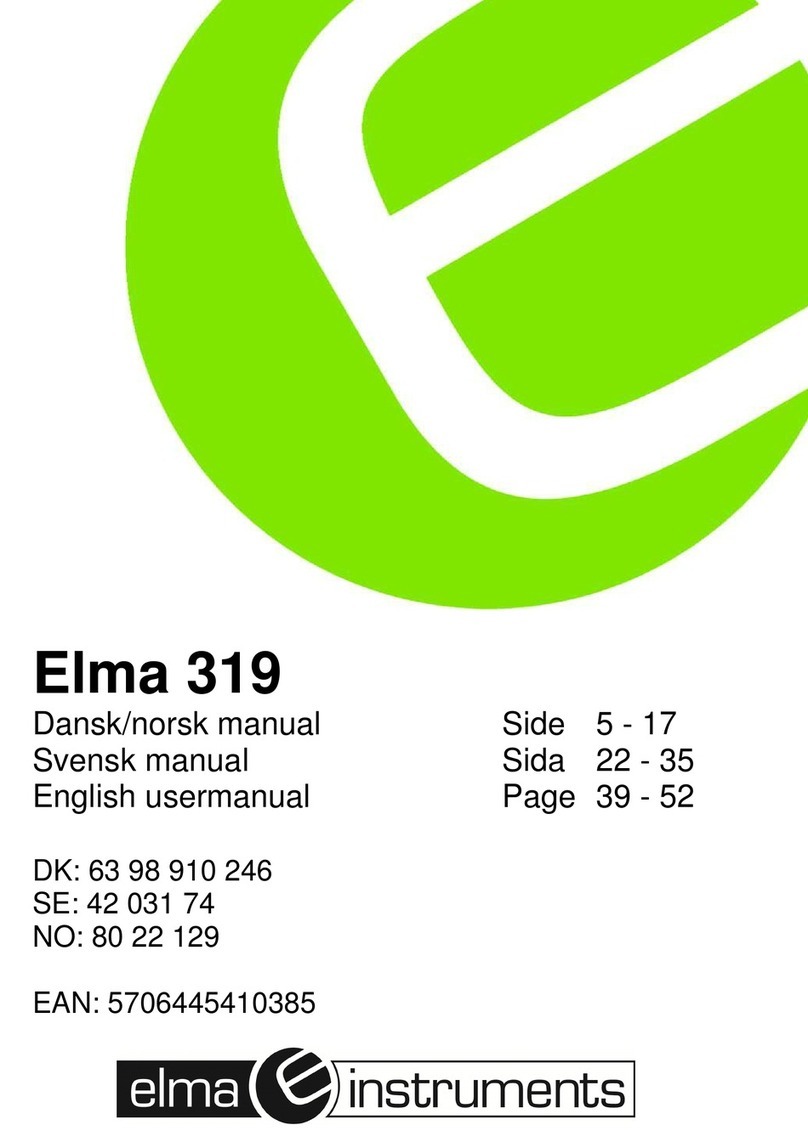
Elma Instruments
Elma Instruments Elma 319 User manual

Elma Instruments
Elma Instruments SAGAB Elma 911 User manual

Elma Instruments
Elma Instruments 3036 User manual
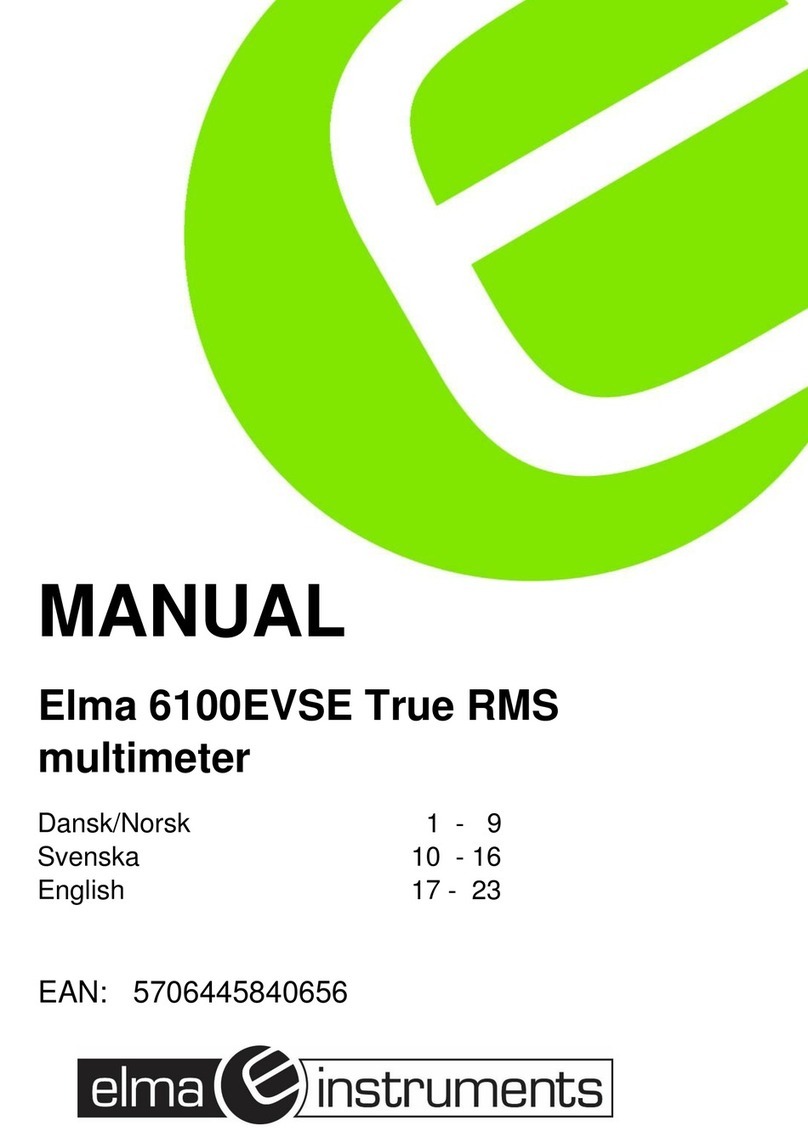
Elma Instruments
Elma Instruments 6100EVSE User manual

Elma Instruments
Elma Instruments 22s User manual

Elma Instruments
Elma Instruments Auto-Check Series User manual

Elma Instruments
Elma Instruments Elma 6100BT User manual
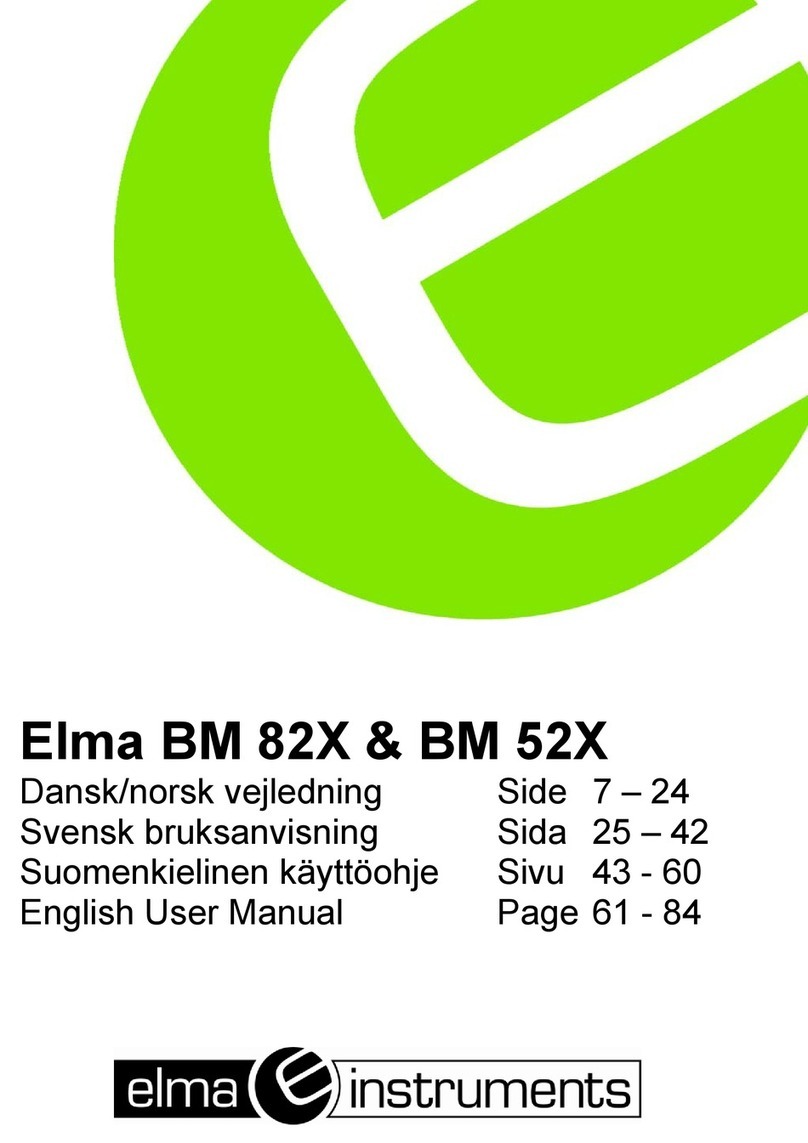
Elma Instruments
Elma Instruments BM 82 Series User manual
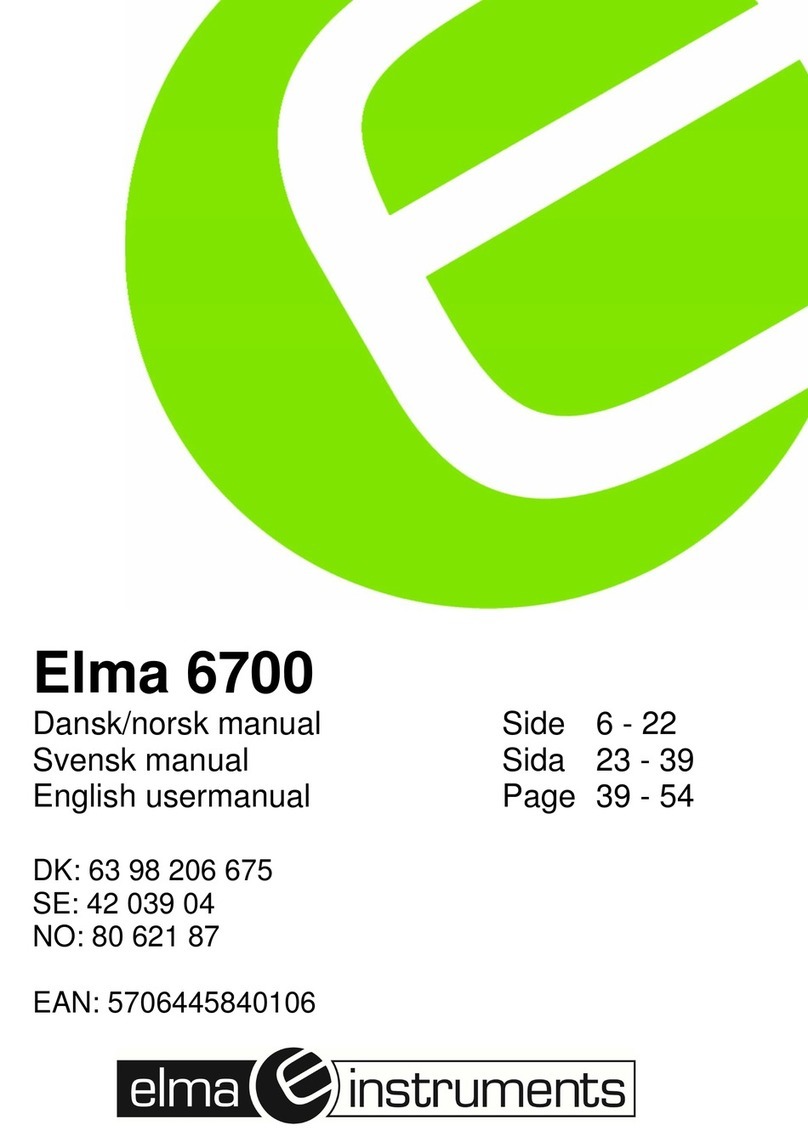
Elma Instruments
Elma Instruments 6700 User manual
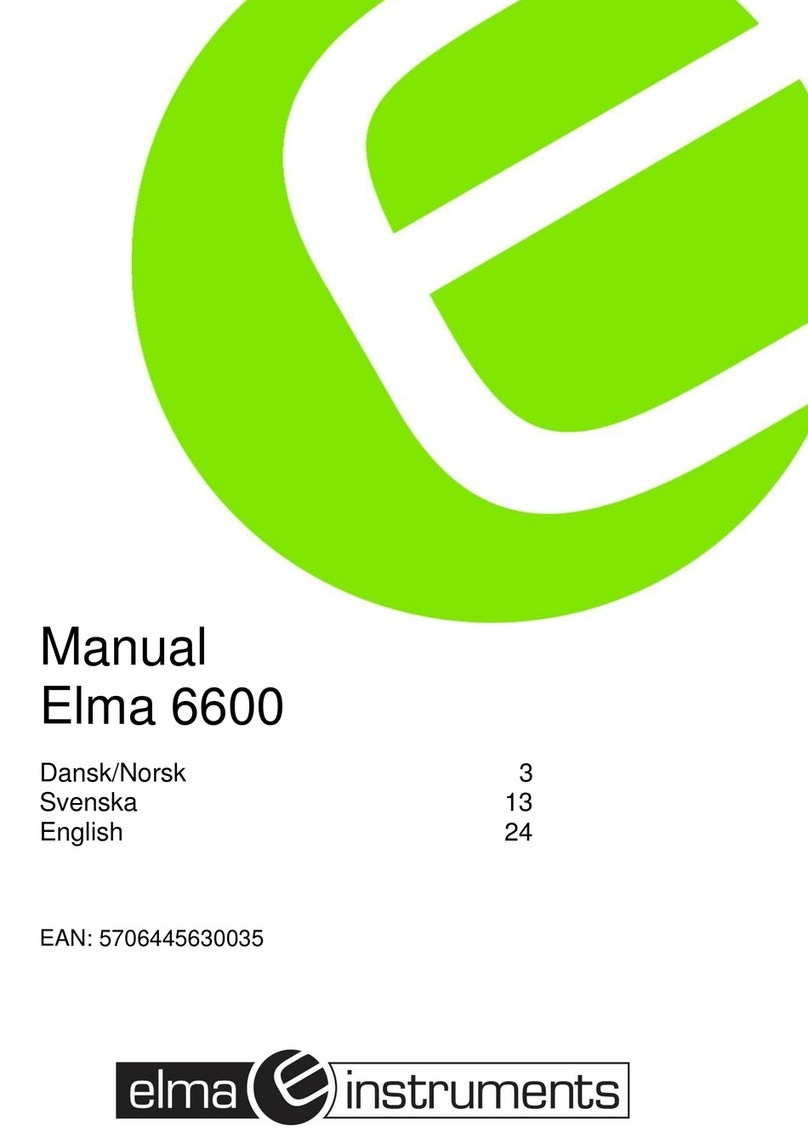
Elma Instruments
Elma Instruments 6600 User manual
